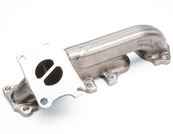Engine Exhaust Simulator (EES)
We designed the EES to perform high temperature durability testing of exhaust components. Its primary purpose is to simulate the hot gas that would be generated by an engine dynamometer during an exhaust manifold durability test cycle.
The EES does not replace the dyno testing, but it’s a complementary test method that helps us evaluate new designs, new materials, CAE model validation and innovative products. Avoiding manifold failure through better design and analysis procedures results in significant savings for Wescast and OEMs in material, tooling and testing costs.
Our in-house Engine Exhaust Simulator can quickly replicate the durability cycles of an engine.
Other testing and uses for EES
- New material durability evaluation
- A to B comparisons (cast vs. fabricated, etc.)
- Fastener strategy evaluation
- Manifold gasket evaluation
- Thermal barrier coating evaluation
- FE model validation
- Other exhaust system component testing
Additional Capabilities
- Videoprobe inspections of internal features
- Leak testing
- 1-D or 2-D displacement measurements with non-contact vision system and contact sensors
- Liquid penetrant, x-ray and magnetic particle NDE of manifolds
- Real-time infrared thermography (IR)
- Electrodynamic shaker

Exhaust Gas Simulator
Material Testing

Tension
The tension test is one of the most commonly used tests for evaluating materials. It can provide force-extension data that can quantify several important mechanical properties of a material, such as Offset Yield Strength (YS), Ultimate Tensile Strength (UTS) and Elongation, which are measures of strength and the ductility of a material.
Dilatometer
The Dilatometer test is used to detect the phase change temperature (Ac1) and determine the coefficient of thermal expansion (CTE) over a range of temperatures by measuring the thermal expansion characteristics.
Brinell
The Brinell test is used to determine the hardness of a metallic material. The results may correlate with the tensile strength, wear resistance, and machinability of the material.
Charpy
The Charpy test is useful in determining the ductile-brittle transition temperature range as the ductility of the material changes with temperature.


